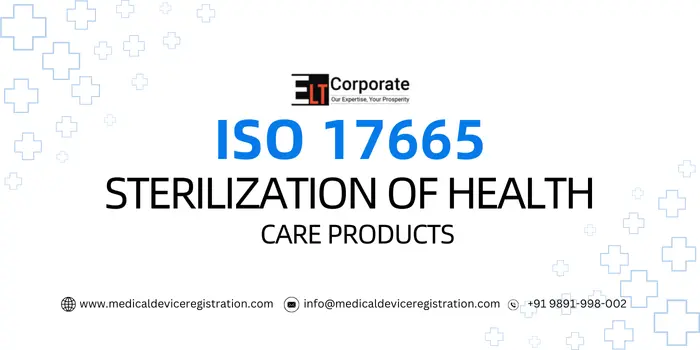Sterilization is the backbone of safe healthcare practices, ensuring that medical devices are free from harmful microorganisms like bacteria, viruses, and fungi. ISO 17665 is an international standard that sets the guidelines for sterilizing medical devices using moist heat, commonly known as autoclaving. This standard ensures that sterilization processes are effective, consistent, and meet global safety benchmarks.
In this article, we will let you know about ISO 17665, its importance, methods, and how it helps prevent infections in healthcare settings.
Overview Of ISO 17665
ISO 17665 is an international standard that is ruled by sterilization of medical devices through the utilisation of moist heat, commonly referred to as autoclaving. It makes sure that the sterilization procedure meets global standards, confirming the safety of medical devices used in healthcare settings. These standards assist in eliminating harmful microorganisms, commonly known as bacteria, viruses, and fungi from all medical instruments, and aid in decreasing the risk of infection for patients and healthcare workers. Check this article to know all the details related to ISO 17665.
Why Is ISO 17665 Important?
It ensures effective sterilisation, avoids the risk of infection and ensures the safety of the medical instrument utilised in healthcare. Through ISO 17665, healthcare providers can confirm that their sterilisation procedure meets international standards, protecting both patients and healthcare workers.
What Sterilization Methods Does ISO 17665 Cover?
ISO 17665 concentrates on moist heat sterilization, it utilizes steam in pressure to kill dangerous microorganisms on medical devices. This is the most conventional and reliable procedure for instruments that might be handled through high temperatures.
What Is Moist Heat Sterilisation in ISO 17665?
Moist heat sterilisation, known as autoclaving, includes using steam at oppressive heat (generally between 121 Celcius and 134 Celsius) to eliminate germs. The steam is absorbed into the instrument, confirming that there are no dangerous organisms present in the device.
How Does ISO 17665 Prevent Infection?
By placing rigorous standards on how to sterilize medical instruments, ISO 17665 confirms that instruments are tidy and secure to use on patients. This saves cross-foulness and the distribution of infections by improperly sterilized equipment.
What Parameters Are Important For Sterilisation in ISO 17665?
Three parameters are important for sterilisation standards in ISO 17665. Check out the points mentioned below to know the details:
- Temperature – The temperature should be relatively high for instance, 121 C to 134 C to eliminate germs.
- Pressure – Increased pressure benefits the steam temperature and enables it to penetrate deep into devices.
- Time – The items required to be susceptible to the correct temperature and pressure for an unchanging amount of time, generally between 3 to 30 minutes, contingent on the procedure.
What About Packaging In Sterilisation in ISO 17665?
ISO 17665 focuses on the devices that must be packed properly to evade re-contamination after sterilization. Packaging has to let steam infusion, and it must be durable enough to withstand the sterilization procedure without disintegrating.
Does ISO 17665 Apply To All Medical Devices?
ISO 17665 implements reusable medical devices, for example, all those that are heat sensitive or have electronics may require other procedures of sterilization, gas sterilization or dry heat.
What Risks Come From Not Following ISO 17665?
Not meeting ISO 17665 standards can directly result in contaminated instruments, which can increase the danger of hospital-acquired risks like HAIs. This might lead to complications for patients, extended hospital stays, and also death. It could result in legal and regulatory repercussions for healthcare facilities.
Documents Required For ISO 17665
Here we have listed all the documents required for ISO 17665 registration. However, you may need some other documents for the registration that can be only known through regulatory consultancy. Check the list mentioned below:
- Validation Records
- Chemical Indicator (CI) Results
- Sterilization Cycle Records
- Biological Indicator (BI) Results
- Equipment Calibration and Maintenance Logs
- Packaging and Storage Documentation
- Sterilizer Performance Testing Records
- Personnel Training Records
- Corrective and Preventive Action (CAPA) Records
- Audit and Inspection Reports
- Sterilization Procedure Documentation
- Supplier and Equipment Qualification Records
- Sterilization Records for Individual Items
- Environmental Control Records
- Sterilization Loan Records
How Does ISO 17665 Reduce Hospital Infections?
ISO 17665 makes it clear that medieval instruments are completely sterilized, which mainly decreases the risk of hospital-acquired infections (HAIs). This simply means devices that are used on patients are not harmful, and free from microorganisms, also improves patients safety.
How Does ISO 17665 Affect Patient Safety?
The ISO 17665 assists in confirming that medical devices are properly cleaned, making sure they’re safe to utilize on patients. This decreases the danger of infection and improves proper patient care and safety.
What Are The Advantages Of ISO 17665?
The advantages of ISO 17665 assure reliable sterilization, benefits in preventing infections, and guarantees that healthcare conveniences comply with legal regulations, all of which provide a safer and high-quality healthcare environment.
Conclusion
ISO 17665 plays an essential role in making sure that the effectiveness and safety of sterilization processes in healthcare environments. By concentrating on moist heat sterilization, the standard assists in preventing the spread of infections and saves both the patient and healthcare provider from dangerous microorganisms. Daily staff training, instrument validation, and detailed papers are important factors in accomplishing and maintaining ISO 17665 compliance.
What Is The Main Sterilisation Method In ISO 17665?
The main sterilization in the ISO 17665 procedure is moist heat sterilization, generally known as autoclaving.
Can ISO 17665 Help Prevent Hospital Infections?
Yes, ISO 17665 is important in preventing hospital infections, by eliminating dangerous bacteria earlier they come into contact with patients.
How Can Healthcare Facilities Ensure Compliance With ISO 17665?
Healthcare facilities can easily ensure compliance with ISO 17665 by training staff members, daily validating sterilization, and performing routine maintenance of every sterilization cycle and procedure.


Comments are closed